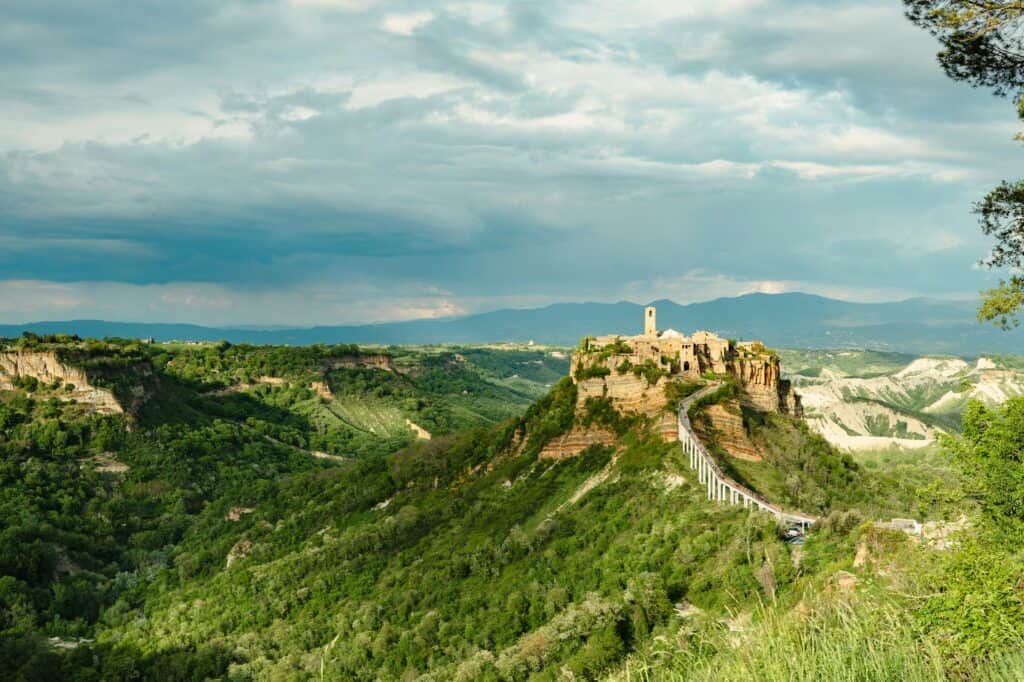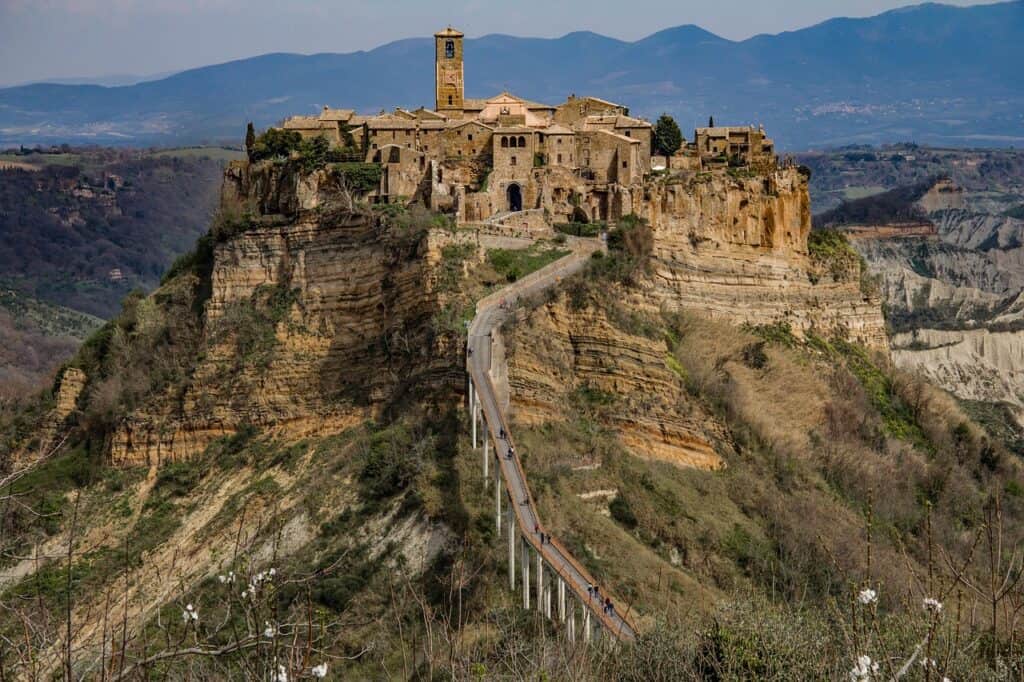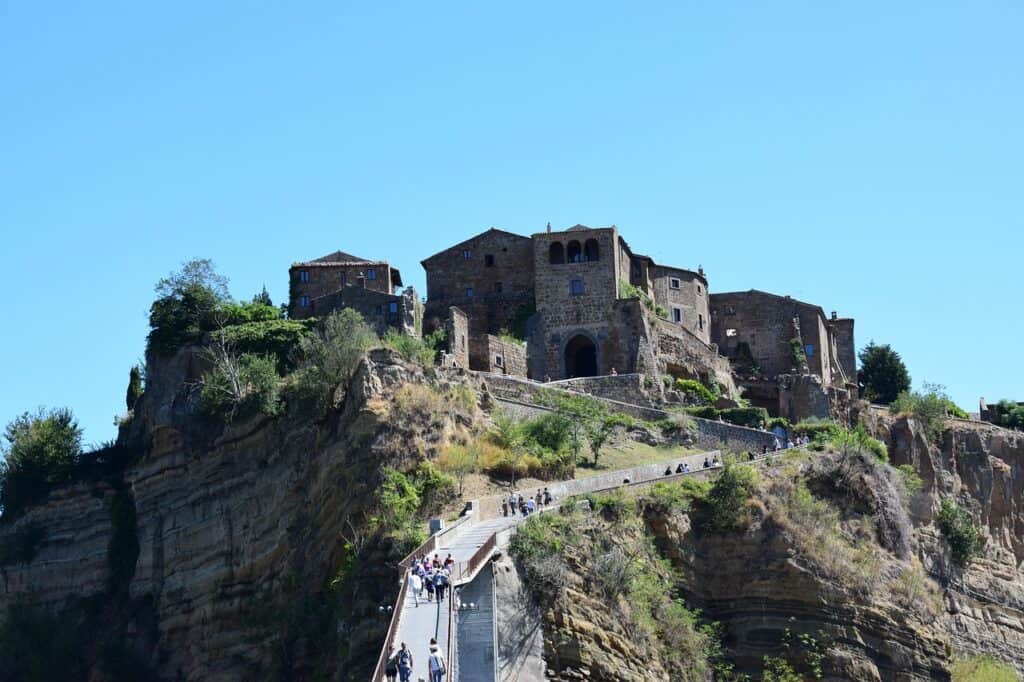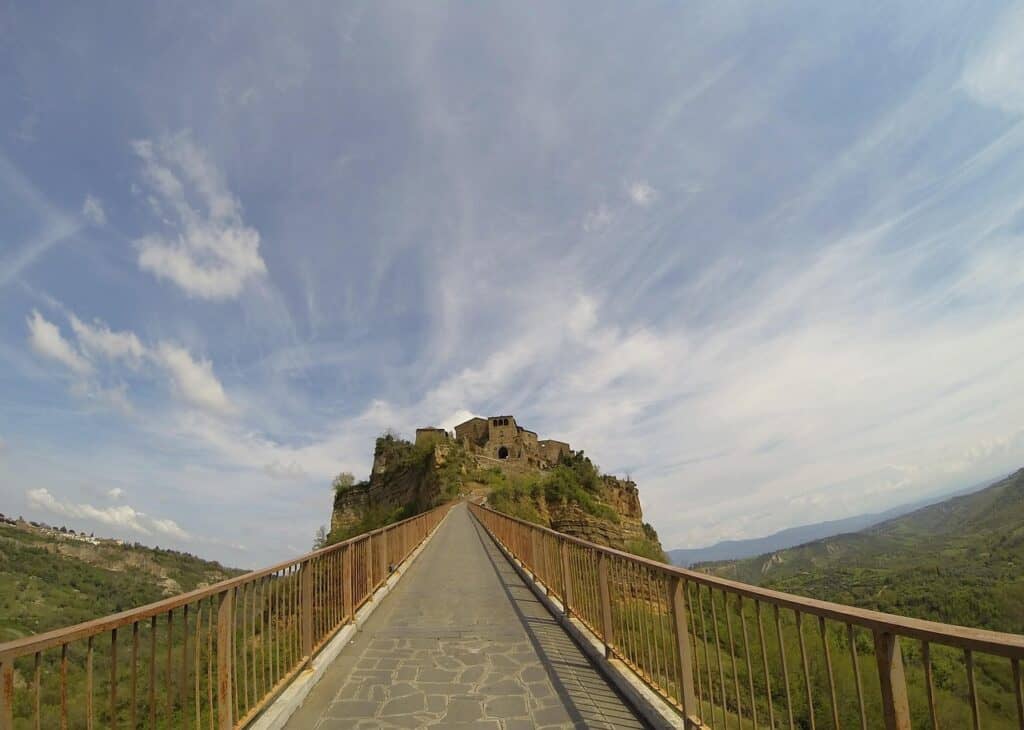We may earn money or products from the companies mentioned in this post. This means if you click on the link and purchase the item, I will receive a small commission at no extra cost to you ... you're just helping re-supply our family's travel fund.

Civita di Bagnoregio isn’t the kind of place you stumble upon. It rises from a ridge of soft volcanic stone in the heart of central Italy, cut off from the modern world by a long pedestrian bridge and centuries of silence. From a distance, it looks almost unreal, a golden village floating above the valley, framed by clouds and light.
The locals call it “the dying city,” but that title feels misleading. Civita isn’t dying so much as holding its ground against time itself. With barely a dozen full-time residents and constant threats from erosion, it survives through care, tourism, and sheer will. Walking its narrow streets feels less like sightseeing and more like stepping into a world that refused to move on.
How this cliff town came to be

The story of Civita begins with the Etruscans, who built the first settlements here more than two thousand years ago. They carved homes, wells, and tunnels into the volcanic rock known as tuff. It was easy to shape but not built to last forever.
Over centuries, water and wind ate away at the cliffs. Earthquakes split the ground, and parts of the town slid into the valley below. By the seventeenth century, so much land had vanished that the bishop and most residents moved to nearby Bagnoregio.
Civita was left behind, shrinking year by year. What remains today is a fragment of that ancient town, suspended between survival and collapse, worn but stubbornly alive.
Step through the city’s stone gate, and every sound of the present fades away.
The approach across the skyway
You reach Civita by a narrow bridge that stretches across the canyon. The walk is steep and open to the wind, but each step brings you closer to something remarkable.
Halfway across, you start to notice how quiet it gets. The road noise fades, replaced by birds and your own breath. At the far end stands the arched gateway, Porta Santa Maria, its stone glowing in the sun. Beyond it lies a village caught between heaven and history.
Inside the walls
Civita is small, but every corner feels alive with memory. The main square sits at its heart, anchored by a modest church and a cluster of houses dressed in ivy and flowers.
Follow the narrow lanes and you’ll find tiny archways, steps leading to nowhere, and sudden views where the land has fallen away. From those ledges, the valley looks endless.
Shops and cafés blend into the old stone, serving handmade ceramics, olive oil, and cold wine to travelers. Cats sun themselves on the walls, and doors stay open long enough for conversation.
There’s no traffic, no rush, and barely a sound. The stillness feels deliberate, as if the town itself is choosing to rest.
Why people call it the dying city

Civita’s nickname comes from the ground beneath it. The village stands on layers of volcanic tuff and clay, both easily eroded by rain and wind. With every storm, small pieces of the cliff give way, and the edge creeps closer.
Engineers have tried to slow the process with retaining walls and drainage systems, but erosion never really stops. It only pauses.
Ironically, the fear of loss has helped save Civita. Visitors come precisely because it feels temporary, and the entry fees help fund preservation projects. The dying city survives because people refuse to let it die.
When to visit and what to expect
Spring and autumn are the best times to come. The light is soft, the weather mild, and the crowds smaller. Summer brings more visitors and heat, while winter can wrap the valley in fog that makes the village look like it’s floating.
You’ll park in Bagnoregio and walk across the bridge on foot. The climb takes about fifteen minutes. It’s not long, but the incline is steady, so good shoes and a slow pace make all the difference.
The Middle Ages preserved

Civita doesn’t pretend to be something new. Its beauty lies in how little it has changed. The streets remain uneven, the stone walls worn smooth by generations. Wooden beams and hand-cut doors tell the story of work done by hand and built to endure.
You can still see Etruscan caves, medieval arches, and wells carved into the rock. The town’s rhythm follows the sun, not the clock. Morning light washes the piazza, and by evening, it glows in the color of baked clay.
Stay after dark if you can. When day-trippers leave and the bridge empties, Civita becomes completely still. The only sound left is the wind moving through its ancient stones.
Why Civita matters
Civita di Bagnoregio is more than a scenic relic. It’s a rare meeting point between nature and human history, a place that shows both how civilizations endure and how easily they can vanish. Italy placed it on UNESCO’s Tentative List in 2017, hoping to preserve its cultural and geological heritage for the future.
What keeps it alive isn’t just restoration, but reverence. Visitors move slowly here, aware they’re walking through something fragile. The town teaches patience, humility, and the quiet power of preservation.